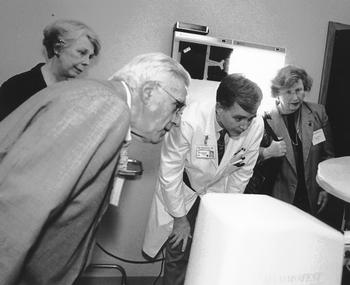New biopsy technique may boost accuracy

Dr. Dan Beauchamp (second from right) with members of the Vanderbilt Cancer Center Board, including, from left, Peggy Wood, Tony Martell, and Faye Pierce. (Photo by Donna Jones Bailey.)
Radiologists and surgeons at the Vanderbilt Breast Center are combining their expertise to offer women a computer-assisted biopsy option that is potentially more accurate and more comfortable than other techniques.
Computer-assisted breast biopsy has been offered at Vanderbilt for several years, but the Breast Center has recently obtained the latest, state-of-the-art equipment using computer-assisted image guidance in combination with the Mammotome.
This technology and equipment offers several advantages over other systems, say Dr. R. Daniel Beauchamp, professor of Surgery and Cell Biology and chief of the division of Surgical Oncology, Dr. Mark Kelley, assistant professor of Surgery and clinical director of the Breast Center, and Dr. Alan J. Kaufman, associate professor of Radiology and Radiological Sciences and director of Breast Imaging.
The Mammotome provides superior breast biopsy samples and allows for multiple sampling without removal of the needle, while the stereotactic unit enables a woman to lie down while the equipment very accurately localizes the lesion, they say.
The procedure also highlights an advantage of the multi-disciplinary Breast Center: close collaboration among experts from a number of fields to improve patient care.
"The most advantageous feature is that Dr. Beauchamp and I do this together," said Kaufman.
"We are truly a team. Patients benefit from the expertise of both a radiologist and a surgeon planning and evaluating together. We believe that combining our expertise enhances the accuracy of the diagnosis as well as the opportunities for appropriate follow-up care."
Stereotactic breast biopsy provides "real-time" images of the breast. The surgeon can be more certain that potentially malignant tissue from a lump — rather than adjacent tissue — has been removed for examination.
"Because I can actually see immediately that I've gotten the lesion, I feel more confident doing breast biopsies this way," said Beauchamp.
Earlier detection of breast cancer, when a tumor is small and localized, can greatly improve a woman's chance of being cured, Beauchamp said. Such small lumps are often detected by mammography, but an additional step, a diagnostic tissue biopsy, is needed to determine conclusively whether the lesion is malignant.
Until about five years ago, when a non-palpable lesion was detected by mammography, biopsy typically involved open surgery, he said. The procedure involved either local anesthetic with sedation or general anesthesia.
"This required a trip to the operating room and usually meant involvement of an anesthesiologist," said Kelley.
"Now we can do biopsies in the Breast Center, under local anesthetic, using the stereotactic imaging system. The cost is one third to one half the costs of an open biopsy and the patients have less discomfort and a smaller scar."
The stereotactic digital imaging system takes images of the breast at plus-15-degree and minus-15-degree angles, Kaufman said.
""The computer calculates the depth and exact location of the lesion," he said. "The computer then targets the needle to that point in the breast."
The woman lies face down on a table, which is more comfortable than sitting up and reduces the risk of fainting. The breast is positioned through a hole in the table and is compressed, much like during a mammogram.
The needle is manually inserted into the lesion, guided by the coordinates calculated by the computer, and tissue is removed through the needle.
Beauchamp, Kelley and Kaufman review the real-time image of the breast on the computer screen to assess the accuracy of the biopsy. They can see whether the Mammotome has "hit the target" and whether part or all of the lesion has been removed.
Another advantage to the Mammotome system is that the head of the needle rotates. "That allows us to do multiple biopsies without removing the needle," Beauchamp said.
Although the needle can often remove all of a very small lesion, the technique is not considered therapeutic, he said. Therefore, a tiny titanium clip is inserted into the breast to mark the location of the lesion in case it is found to be malignant and additional tissue must be removed later.
The entire procedure usually takes less than an hour.
"Because there's no sedation, the woman can drive herself home if she wants," Kelley said. "Patients may resume normal activity the day after the biopsy."













